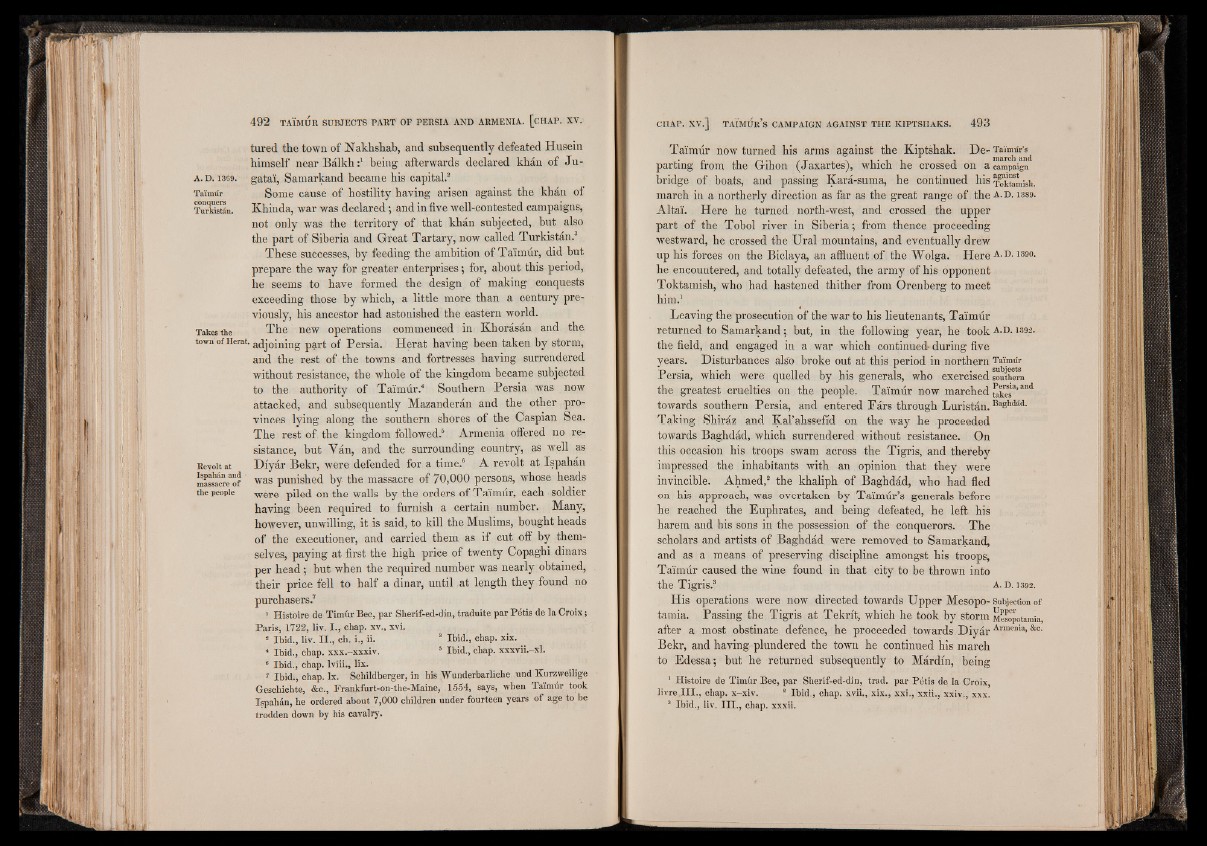
tured the town of Nakhshab, and subsequently defeated Husein
himself nearBalkh:1 being afterwards declared khan of Ju-
a . d . 1369. gata'i, Samarkand became bis capital.2
Taimiir Some cause of hostility having arisen against the khan of
TuriSn. Khinda, war was declared; and in five well-contested campaigns,
not only was the territory of that khan subjected, but also
the part of Siberia and Great Tartary, now called Turkistan.3
These successes, by feeding the ambition of Taimur, did but
prepare the way for greater enterprises; for, about this period,
he seems to have formed the design of making conquests
exceeding those by which, a little more than a century previously,
his ancestor had astonished the eastern world.
Takes the The new operations commenced in Khorasan and the
town of Herat, adjoining part of Persia. Herat having been taken by storm,
and the rest of the towns and fortresses having surrendered
without resistance, the whole of the kingdom became subjected
to the authority of Taimur.4 Southern Persia was now
attacked, and subsequently Mazanderan and the other provinces
lying along the southern shores of the Caspian Sea.
The rest of the kingdom followed.5 Armenia offered no resistance,
but Van, and the surrounding country, as well as
Revolt at Diyar Bekr, were defended for a time.6 A revolt at Ispahan
mSa«e™f was punished by the massacre of 70,000 persons, whose heads
the people were piled on the walls by the orders of Taimur, each soldier
having been required to furnish a certain number. Many,
however, unwilling, it is said, to kill the Muslims, bought heads
of the executioner, and carried them as if cut off by themselves,
paying at first the high price of twenty Copaghi dinars
per head; but when the required number was nearly obtained,
their price fell to half a dinar, until at length they found no
purchasers.7
1 Histoire de Timur Bee, par Sherif-ed-din, traduite parPd tis de la Croix;
Paris, 1722, liv. I ., chap. xv., xvi.
2 Ibid., liv. I I ., ch. i., ii. 8 Ibid., chap. xix.
* Ibid., chap. xxx.-xxxiv. 5 Ibid., chap. xxxvii.-xl.
6 Ibid., chap. lviii., lix.
7 Ibid., chap. Ix. Schildberger, in his Wunderbarliehe und Kurzweilige
Geschichte, &c., Frankfurt-on-the-Maine, 1554, says, when Taimur took
Ispahan, he ordered about 7,000 children under fourteen years of age to be
trodden down by his cavalry.
Taimur now turned his arms against the Kiptshak. De- Ta,n£if’sd
parting from the Gihon (Jaxartes), which he crossed on a campaign
bridge of boats, and passing Kara-suma, he continued his Toktamish.
march in a northerly direction as far as the great range of the a . d . 1389.
Altai. Here he turned north-west, and crossed the upper
part of the Tobol river in Siberia; from thence proceeding
westward, he crossed the Ural mountains, and eventually drew
up his forces on the Biclaya, an affluent of the Wolga. Here A-D- 139°-
he encountered, and totally defeated, the army of his opponent
Toktamish, who had hastened thither from Orenberg to meet
him.1
Leaving the prosecution of the war to his lieutenants, Taimur
returned to Samarkand; but, in the following year, he took A-D- 1392-
the field, and engaged in a war which continued- during five
years. Disturbances also broke out at this period in northern Taimur
Persia, which were- quelled by his generals, who exercised southern
the greatest cruelties on the people. Taimur now inarched mkeT’a”d
towards southern Persia, and entered Fars through Luristan.Baghdid-
Taking Shiraz and Kal’ahssefid on the way he proceeded
towards Baghdad, which surrendered without resistance. On
this occasion his troops swam across the Tigris, and thereby
impressed the inhabitants with an opinion that they were
invincible. Ahmed,2 the khaliph of Baghdad, who had fled
on his approach, was overtaken by Taimur’s generals before
he reached the Euphrates, and being defeated, he left his
harem and bis sons in the possession of the conquerors. The
scholars and artists of Baghdad were removed to Samarkand,
and as a means of preserving discipline amongst his troops,
Taimur caused the wine found in that city to be thrown into
th e Tigris.3 a . d . 1392.
His operations were now directed towards Upper Mesopo- Subjection of
tamia. Passing the Tigris at Tekrft, which he took by storm Mesopotamia,
after a most obstinate defence, he proceeded towards Diyar Armenia>&c-
Bekr, and having plundered the town he continued his march
to Edessa; but he returned subsequently to Mardin, being
1 Histoire de Timur Bee, par Sherif-ed-din, trad, par Petis de la Groix,
liv re .III., chap. x-xiv. 2 Ibid., chap. xvii., xix., xxi., xxii., xxiv., xxx.
3 Ibid., liv. I I I ., chap. xxxii.